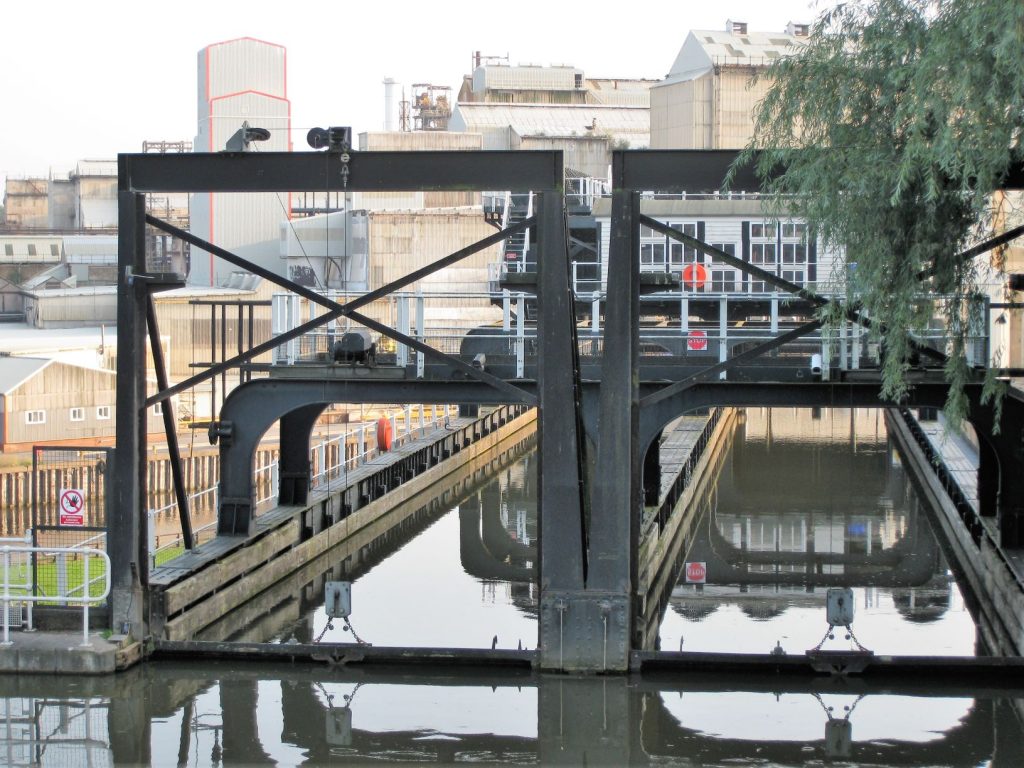
Sailing Through Sale
With Bank Holiday weekend looming and a forecast of hot, sunny weather we could already see the signs of a busy time on the canal. In the morning, as we headed down into a large built up area around Sale there was lots of activity on the moorings, all along the way, with people uncovering their boats, washing them down and stocking them up.
We stopped for supplies ourselves on the mooring at Sale Bridge. It seems to be a very big town but the area by the canal feels quite nice. We had to go through the busy shopping centre to get to Tesco so we saw a little bit of the place and it certainly seemed to be thriving, compared to some of the areas we have passed through.
Knowing we had a fair way to go we got straight back on board and decided to have lunch on the move. There were no locks or bridges on our route today and it was a beautiful day for a cruise.
As we left Sale Bridge you could see it on the map as a huge sprawl of urban development. Although people on the far side would probably claim they were in Altrincham there doesn’t seem to be much division. From the water it doesn’t feel that bad. The towpath continues to be very well made up and runs past gardens, schools and parks. On the offside permanent moorings seem to go on for miles with the railway just the other side of the bank. It makes for slow going when reducing speed to pass these long stretches but it doesn’t make a huge difference overall.
Blame The Parents
You can never really blame the children. Equally you can only ever really blame a dog’s owner. However, it isn’t always easy to see what you have done or how you can make it better.
Bracken is a lovely puppy and will soon be a year old. She is gorgeous, charming, very intelligent, affectionate and forces us to be more active than we might otherwise, which really is a good thing. Nonetheless, despite all the socialization we tried to do, and the training we have been through, there are some fundamentals that are proving really challenging.
On the one hand, she was labelled as ‘wilful’ & ‘independent’ before she even left the breeder at 8 weeks old and that hasn’t changed. A couple of related behaviours in particular make our life difficult and in some ways, the more we try to address them the worse they seem to get. On the other hand, even after nearly four months on the boat, she is palpably anxious and distressed while we are moving, and positively panicky whenever we manoeuvre to pull in to the side or enter locks etc. We have also found that, as the more limited space means both of us are now with her almost constantly, her ability to be left alone for an hour or two, which we had built up at the house, seems to have deserted her. Bold and independent, anxious and unhappy to be left alone, she really is quite the contradiction.
Behaviours change quickly at this stage and it could just be the ‘teenager’ phase so we need to persevere but we are concerned that we may have to think carefully at some point. Both about the impact on us if we aren’t able to address some key issues and about whether, if she can’t adapt to life on the boat enough to stop spending at least part of every day stressed and exhausted, it is fair to impose this life on her.
Lymm Congestion
Breaking free of the urban sprawl we were aiming for Lymm. Looking on the map it seemed like a nice place to stop, with a fish & chip shop, so we were hoping to stay there for a couple of nights and allow the forecast heat wave and the Bank Holiday weekend wash over us.
There are no bridge numbers on the Bridgewater Canal and the bridges over the canal all have names. Another feature in this area is that where the canal crosses over roads, rather than under them, the crossings are labelled on the maps as “underbridges”. We couldn’t work out why these were not either aqueducts, from a canal perspective or tunnels from a road point of view.
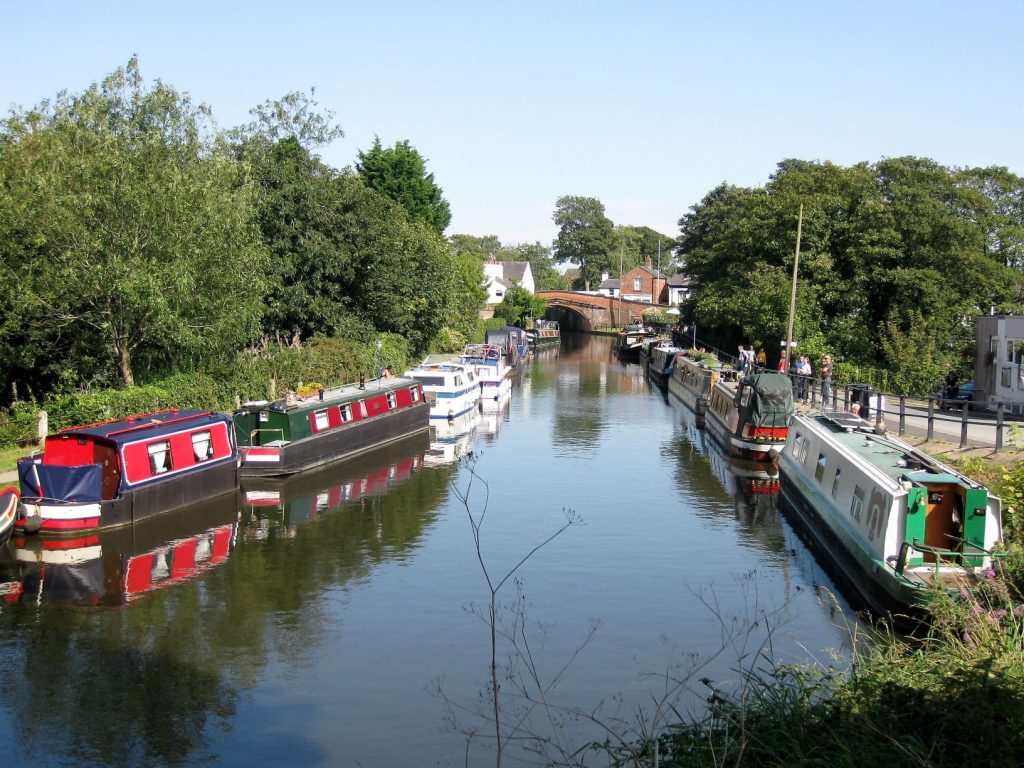
Coming through Lymm Bridge we could see that five o’clock on a Friday evening was not the best time to be arriving here looking for a mooring. We got lucky though, finding a straight spot, just long enough to take us, at the far end, just by Whitbarrow Underbridge. It was under some trees, which might often be a disadvantage but if it was as hot as predicted then it might work out to be a good thing for the next day or two.
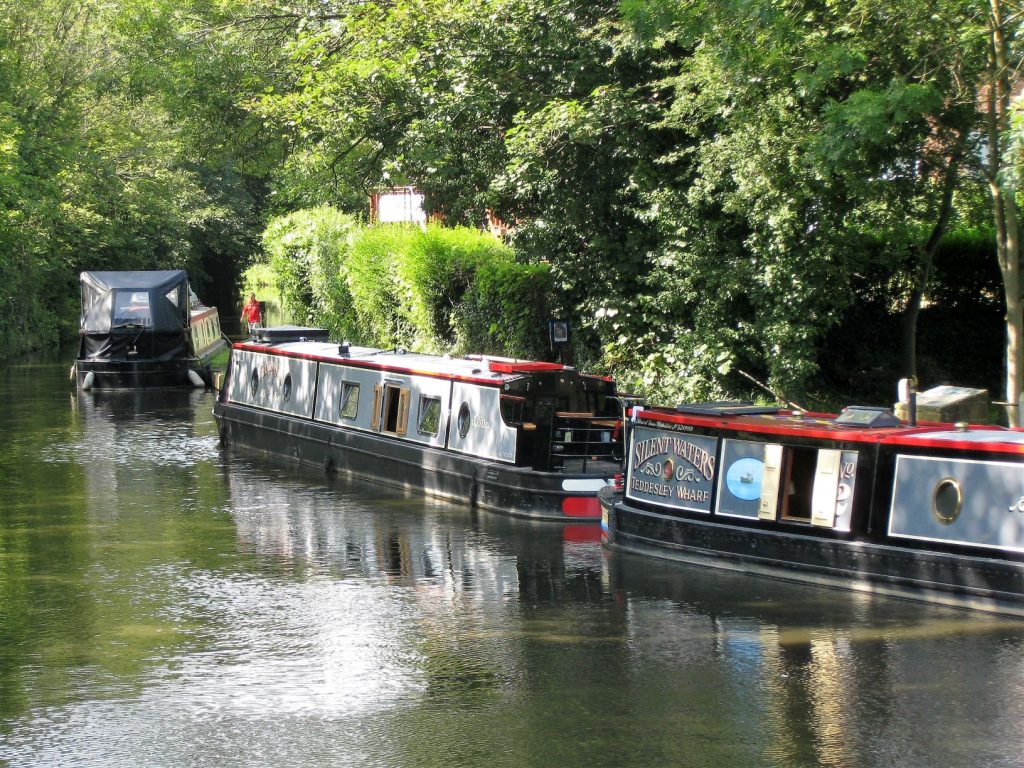
People continued to arrive, even into the darkness, peering hopefully along the crowded bank before giving in to despair, either continuing on into the night or stopping their boat somewhere inappropriate and tying up to whatever street furniture they could find. One enormous wide beam pulled up in front of us with the centre of the boat resting on the apex of a tight bend. This left his bow and stern out in the middle of the channel reducing it to just about a single boat width and so generating queues of traffic on either side. Could he not see this when standing on the bank? Or did he just not care? Hard to say but he wasn’t Lymm’s most popular camper that night.
On Saturday morning we went and had a good look round, following the Lymm Heritage Trail downloaded from their site. It hides it well but you eventually come to see that it is a small town masquerading as a village.. The centre is quite pretty and well kept. The trail takes you out to the Trans Pennine Trail and a very heavily used cycle trail. You come back through Slitten Gorge, where you can see the remains of the water powered Slitting Mill. Apparently this was a business of cutting iron bars, often imported, into nails. It seems this was a vital industry for the country and of sixteen recorded slitting mills a disproportionate number were in this part of the country.
Passing under the canal and through the centre you head out through a pretty grove called The Dingle and find yourself at Lymm Dam. The most striking feature here is that this not a dam. There is no vast curtain wall holding back millions of tonnes of water, in the style of the Todmorden dam now so familiar to all, just a large lake with pleasant paths, fishing stands and picnic areas all around it. Local opposition prevented a new turnpike road from Warrington to Stockport, which is now the A56, coming through the centre of the village. It was re-routed across the valley below St. Mary’s Church, requiring that an earth coffer dam be built across a stream and pool, which then formed the Lymm Dam lake. The trail takes you all the way round the “dam” and by the time we were back in the village it was time to seek out the shade by the boat to avoid the heat of the afternoon.
Lymm “Dam”
The fish & chips on Friday were good, there were lots of recreation spaces, it was very busy with visitors and locals alike, there are plenty of nice pubs and bars, all in a bright, sunny picturesque setting, bustling with boats all weekend. Overall, Lymm lived up to its promise in a way that Worseley really didn’t.
Fun Days & Festivals
Sunday continued the uncharacteristic Bank Holiday heatwave. We had already been in Lymm for two nights and could happily have stayed for a third but mooring there was restricted to forty-eight hours so we had to move on. In any case, we needed to make progress toward the Anderton Boat Lift as we had a date there on Tuesday.
We only cruised for three and a half hours, with a forty minute service stop on the way, before mooring up just by Moorefield Bridge. We expected this to be a fairly isolated ‘wild’ mooring in the countryside. There were a few other boats there but it was pretty much as expected. Having moored up, as we started a late lunch, we were aware of a strange thumping noise in the background and a lot of loud screaming from across the fields.
The first noise was explained by a quick trawl of the internet. It seems that we were in ground shaking earshot of this year’s ‘Creamfest’. This is the kind of music festival I don’t think Ray Baldwin would be attending. We were able to recognise only one name in the line-up, Fat Boy Slim, and the music seemed to be the same drumbeat endlessly repeated, with pauses. The good news was that this was the last day and it was due to finish before seven o’clock. The major noise did stop then but there was a late night laser light show that we got for free after the sun went down.
The second noise, coming from the opposite direction, turned out to be from the Red Lion in Moore, so far across horse paddocks and a railway line that we hadn’t realised it existed. They appeared to be having some sort of Bank Holiday family fun day, involving children and a bouncy castle, which went on for the rest of the afternoon.
After a while we filtered the noise into the background and got on with the afternoon’s task of setting up the anchor with fifty feet of chain, fifty feet of rope and shackles to secure it all to the fixing point in the bow. Everything had to come out of the bow locker and be stowed away again afterwards so it took a while and given the weight of these things combined with the heat of the day, a fair amount of sweat and swearing. Finally, and for the first time this summer, we were ready to start the barbecue. We learnt a lot about lighting fires and barbecues on our trip last year, apparently all very easily forgotten. Nonetheless, two cooked burgers were eventually on the plate and they tasted pretty good.
Tight Tunnels
Bank Holiday Monday was to take us down to Anderton ready for the next day. Another three or four hours cruising that took us through the Preston Brook Tunnel, to leave the Bridgewater and get back onto the Trent and Mersey, which we had left behind when we turned up the Macclesfield Canal back in June. Preston Brook Tunnel is one-way operation with timed entry. If you are travelling South you are allowed to enter the tunnel any time between thirty minutes and forty minutes past the hour. Passage is around fifteen minutes. Northbound traffic is allowed to enter anytime from on the hour to ten minutes past the hour. Somewhat surprisingly, this is completely unsupervised, so look before you leap! Whilst you can see the light at the end of the tunnel, it is far from straight. Its sudden curves will catch you out if you don’t pay attention and could even hide a boat that had jumped the gun. Immediately beyond the tunnel is a stop lock. With a fall of just four inches it seems a little unnecessary these days but it still has to be negotiated like any other lock.
Coming through onto the Trent & Mersey you notice a change immediately. The canal remains as wide initially but there is a lot more vegetation on both sides, the trees seem to close in and the reed beds along the offside seem to have just been left to expand at will, often restricting the channel to almost a single boat width. You get quite a sense of neglect and unchecked entropy compared to the Bridgewater that you have just left behind.
There are two more tunnels before you reach Anderton. Like the Preston Brook Tunnel, both are far too narrow for more than one boat at a time. The first, Saltersford Tunnel, is also timed entry, with Southbound traffic permitted to enter between thirty minutes past the hour and fifty minutes past the hour and passage taking only around five minutes. In this case you can’t even see the light of the far portal at all. Strangely, although equally kinky and the longer of the two, Barnton Tunnel has no such restriction. You just have to have a look and hope for the best.
Having made it through these without incident we stopped on the forty eight hour moorings almost opposite The Stanley Arms and a little short of the boat lift. The thing that was most immediately striking, wandering down to the Visitor Centre, was the huge industrial plant down in the valley, which turned out to be owned by TATA Chemicals Europe.
Winding Down To The Weaver
Tuesday was the morning we were booked to descend to the River Weaver, via the Anderton Boat Lift. You can only enter from one direction so first we had to go past the lift and turn round in the wide basin just beyond and be on the holding mooring half an hour before our booking. The structure is a huge piece of machinery. There are two caissons that boats can be driven into. Each of these iron baths will hold two narrowboats, side be side. We travelled down with a crew that had done the trip literally hundreds of times. They were canal traders who had been moored outside the Visitor Centre over the long weekend, selling their goods to the tourists and they were heading back to their house on the Weaver. I must say that rather undermined our vision of canal traders as hard-bitten, continuous cruisers plying their wares around the network all year round, come what may.
Anderton Boat Lift
As we went down, the other caisson came up the other way, with the trip boat in it. I used to think that the lift operated with the two balancing one another out but this is not true. Each can be operated independently or both can be raised or lowered together, if required. Apparently, I was half right, as our companions told me the operation used to rely on their being counterbalanced originally. When the lift was restored and electrified it was no longer necessary. Nonetheless, it still helps so they usually do work them together in opposite directions and when not in operation they leave both caissons at the bottom to save strain on the structure.
The operation is straightforward. The boats are driven in to the chamber and a barrier raised behind them when they are secured. The caisson descends, very slowly. As it passes the rising caisson you start to see the big column of the hydraulic ram that does the heavy lifting. When the descent is complete the forward barrier is raised and the boats can proceed onto the river. Our companions told me that laser sensors now determine when the descent is complete. It seems these take an age to register and they are often fooled by almost anything, from a slight misalignment through to a spider sitting on the lens. Such issues never dogged the old pressure switch, I was told, that worked much more quickly and had a degree of tolerance for the real world.
Once down at the river level we headed upstream. It was a little like going on the Thames last year, in miniature. As well as the hassle of having to set up an anchor, chain and rope ready to be dropped in an emergency, all the locks are much bigger than on the canals and operated by full time lock keepers. The other key features of river travel are the sense of space, the freedom to do a U-turn almost anywhere and a 6 m.p.h. speed limit rather than 4 m.p.h. Everything is on a larger scale, as some of the vessels using the navigation are getting on for small ships rather than boats. There are a number of swing bridges to accommodate them but most narrowboats can pass beneath without needing to get them opened them, as long as the river level is not exceptionally high.
The Weaver – Up And Down
We were due to go back up to the canal on Thursday afternoon so this was really a short recce to see what’s what on the Weaver and probably return for a longer stay another time. The navigable stretch is about twenty miles long, with the Anderton Boat Lift somewhere near the middle. Upstream you pass through Northwich town and two locks to arrive at the Winsford Bridge. When you pass through there you leave CRT jurisdiction and enter the Winsford Flash at your peril, it looks an inviting expanse of water but is very shallow and you will run aground. However, it is possible to turn and there is even a water point just beyond the bridge, as long as you don’t stray too far. Downstream takes you through two other locks as far as the Weston Marsh Lock, which you can go through onto the Manchester Ship Canal but only by making special arrangements in advance. The navigation does go past Weston Marsh Lock for a short distance around Runcorn to Delamarsh Lock but having been there we didn’t see anything to recommend it.
In the time we had we were able to stop off at Northwich for an hour or so and gained a rather favourable impression of the town. There were some older half timbered buildings as well as some old style shopping precincts and a brand new centre so quite a mix through the ages but it felt busy and vibrant and worth exploring further.
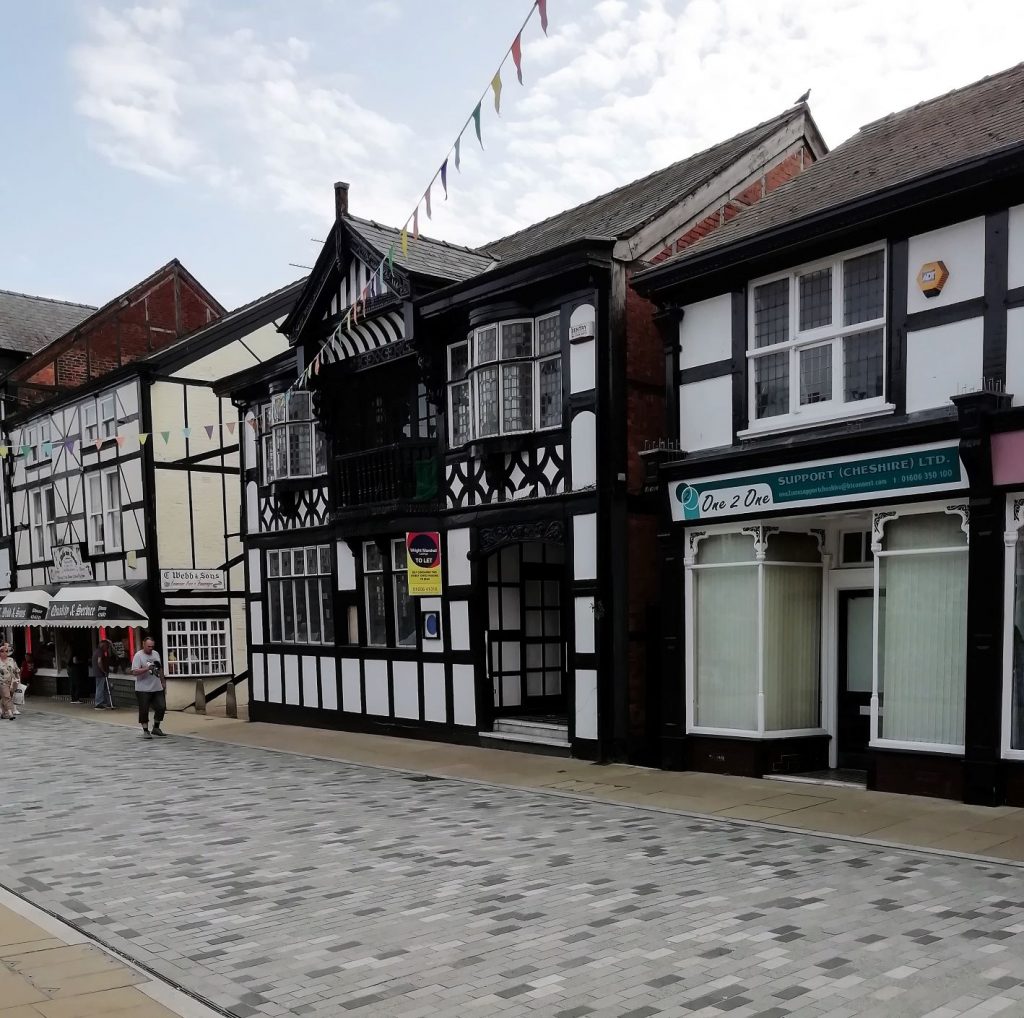
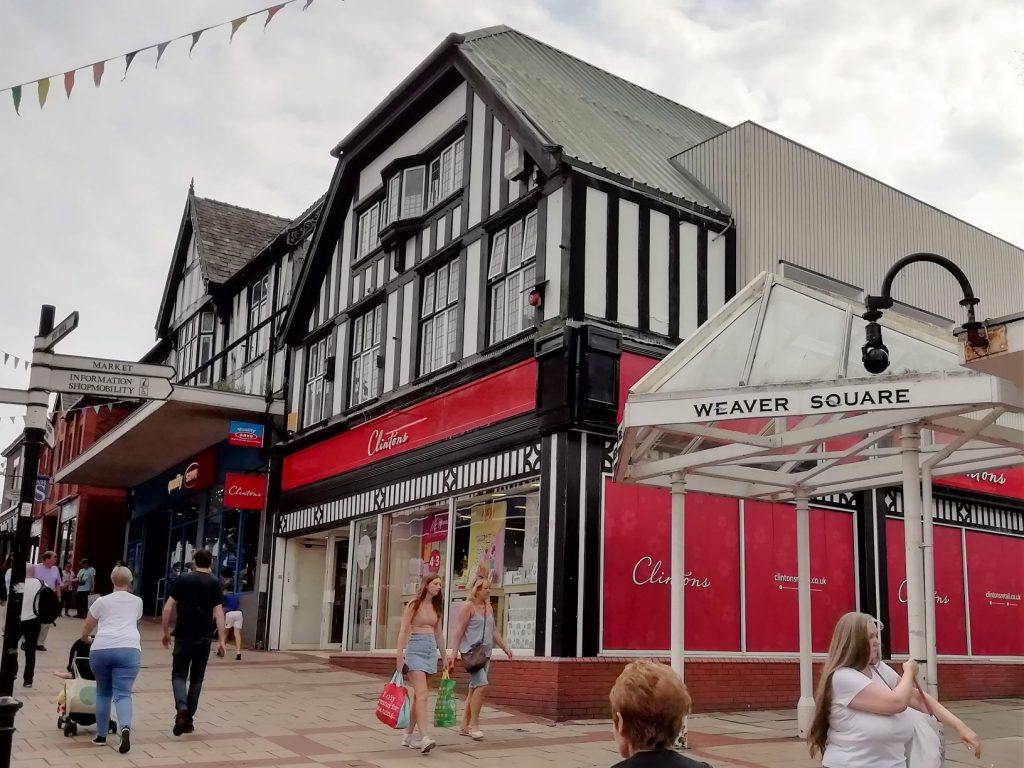
We carried on up to Winsford via Hunts Lock and Vale Royal Lock. All the locks are operated by CRT staff. They are huge locks compared to those we are used to so you phone them when you set out to let them know you are on the way and they try to set the lock for you while you are on the way. They then phone ahead to the next lock and let them know you are on the way to them. This does mean you can’t pass through after they knock off or before they clock on the next day. Unlike Neil Payne’s éclusiers in France, however, they don’t go off to lunch. There seems to be a rivalry between the locks and we were given insults to pass on as we left Hunts Lock.
A River Weaver Lock
We had heard a lot about this river and we expected to find a very rural landscape, all about trees and green fields and weedy river banks. All these are present and correct but the number of massive industrial operations along this section was a surprise. Having at least seen this stretch and turned, without grounding, beyond Winsford Bridge we moored up for the night at a spot just short of Vale Royal Lock. Although there is no requirement for a towpath on the river there was a good track running beside the mooring. Well-used by runners and dog walkers but it really only ran like a causeway between the river on one side and marshy wet ground on the other so not much scope for wider exploration.
River Weaver industry upstream
Wednesday started wet so we delayed setting out but eventually had to don wet weather gear and make a start. First call was Vale Royal Lock, of course, then back through Hunts Lock and Northwich, past the Anderton Boat Lift, through Saltersford Lock and Dutton Lock to Weston Marsh Lock, barring access to the Manchester Ship Canal.
Once past the huge TATA site opposite the boat lift on the way to Saltersford Lock the surroundings become much less industrialised and more like the gentle countryside we had anticipated. This lasts for quite a long way but gives way again to heavy industry as you pass the M56 and Rocksavage to approach Runcorn. All you can see on the North bank is a mass of steel frameworks, pipes, holding tanks etc. for what feels like miles.
Way downstream Runcorn awaits
We did go past Weston Marsh but at this point we were just passing acres and acres of industrial manufacturing plant with nothing else to be seen so we soon turned back. The rain had eased after an hour or so and despite one other heavy shower in the afternoon, much of the day was really quite pleasant, As we made our way to a small mooring just beside Dutton Lock it was a lovely, sunny evening. We found the mooring a bit confusing, as it was clearly marked as a forty eight hour mooring but was also a water point and there was no room for more than one boat. It seemed unlikely that we would be in anyone’s way, however. In any case we couldn’t go anywhere else as it was too late to go back through the lock today, so we tied up here for the night.
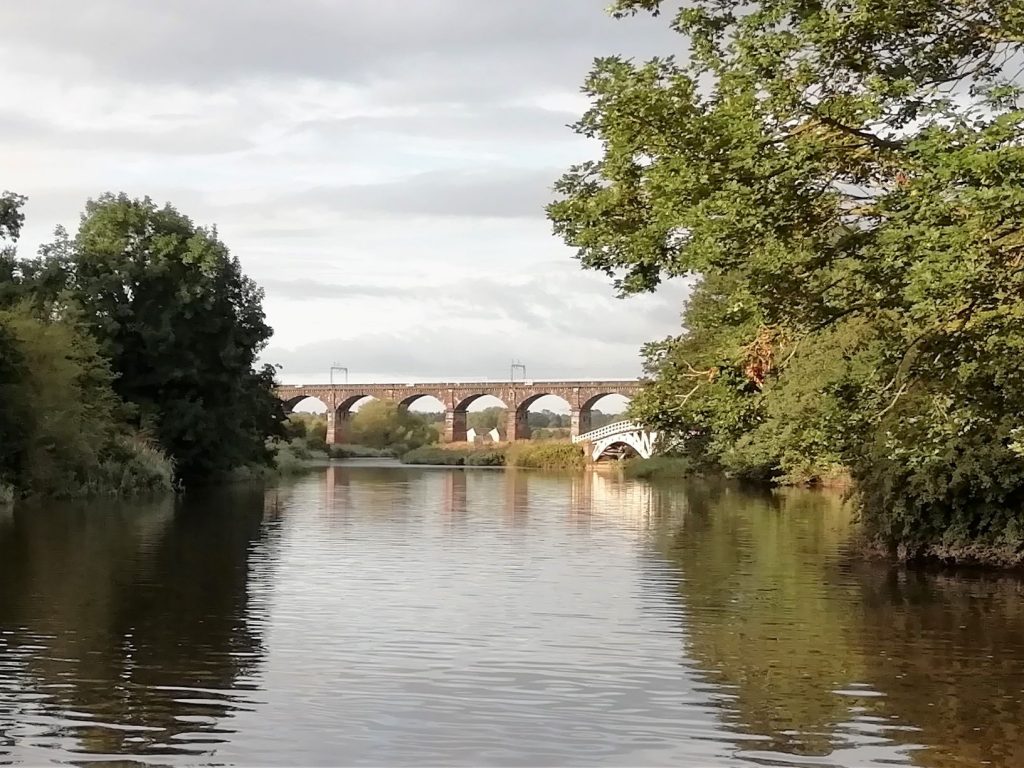
The weather on Thursday was much brighter. Having realised that we were short of milk we got going as soon as the lock was opened so that we would have time to go up to Northwich, pick up some shopping and get back to the Anderton Boat Lift in time to check in there half an hour before our booked passage at two fifteen. As ever, when you are suddenly on a schedule, there was a hitch. Saltersford Lock was not set for us, even though Dutton had phoned ahead. Apparently they had been waiting for a boat that was said to have been on the way down but never showed up. We didn’t see any craft heading that way after we went through either so who knows where they went.
Despite the delay we were back at the lift in good time and back up on the Trent & Mersey by three o’clock. The weather was still fine but the wind had picked up, which made both the ascent and the junction out into the canal more interesting. We only went far enough to get away from the Visitor Centre before mooring up. The nature park here was a great place to give Bracken a good run and hopefully wear her out enough for us to go and eat at the Stanley Arms.

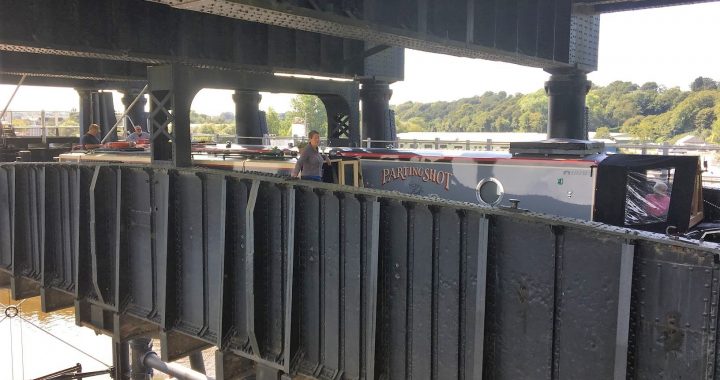

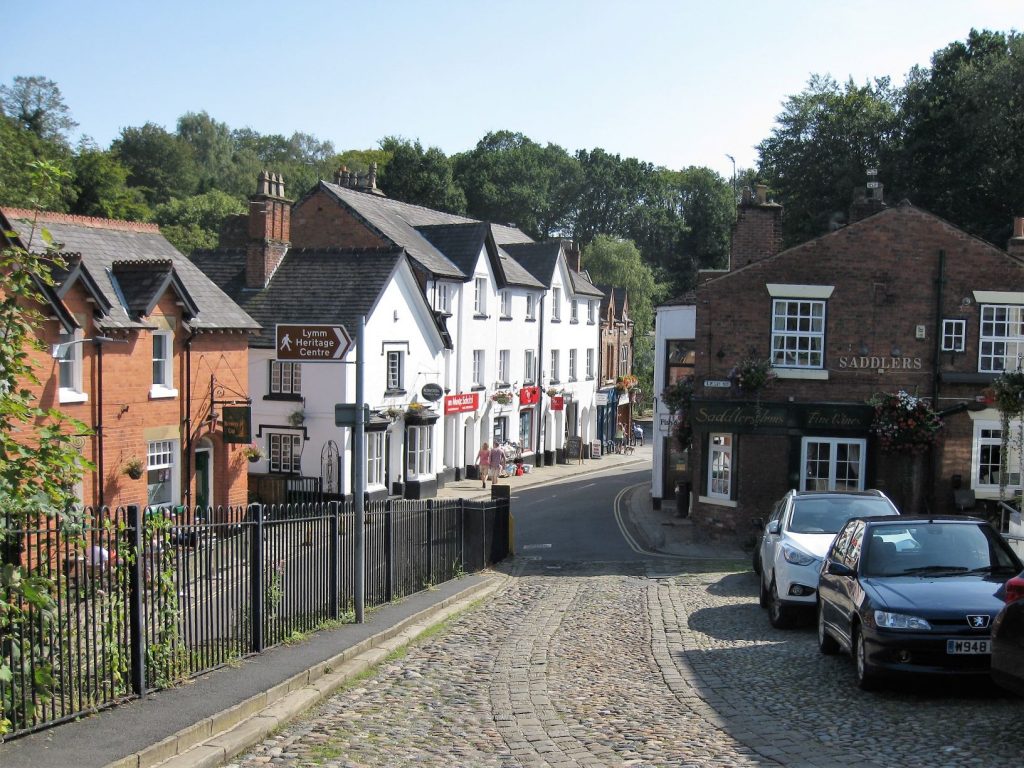
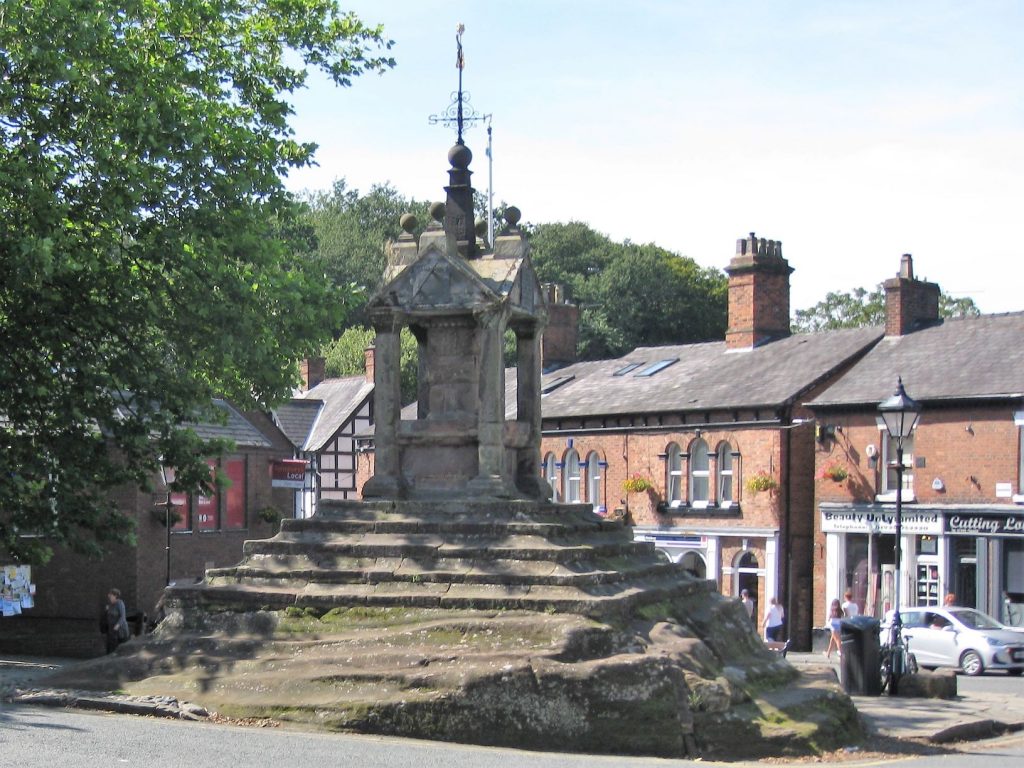
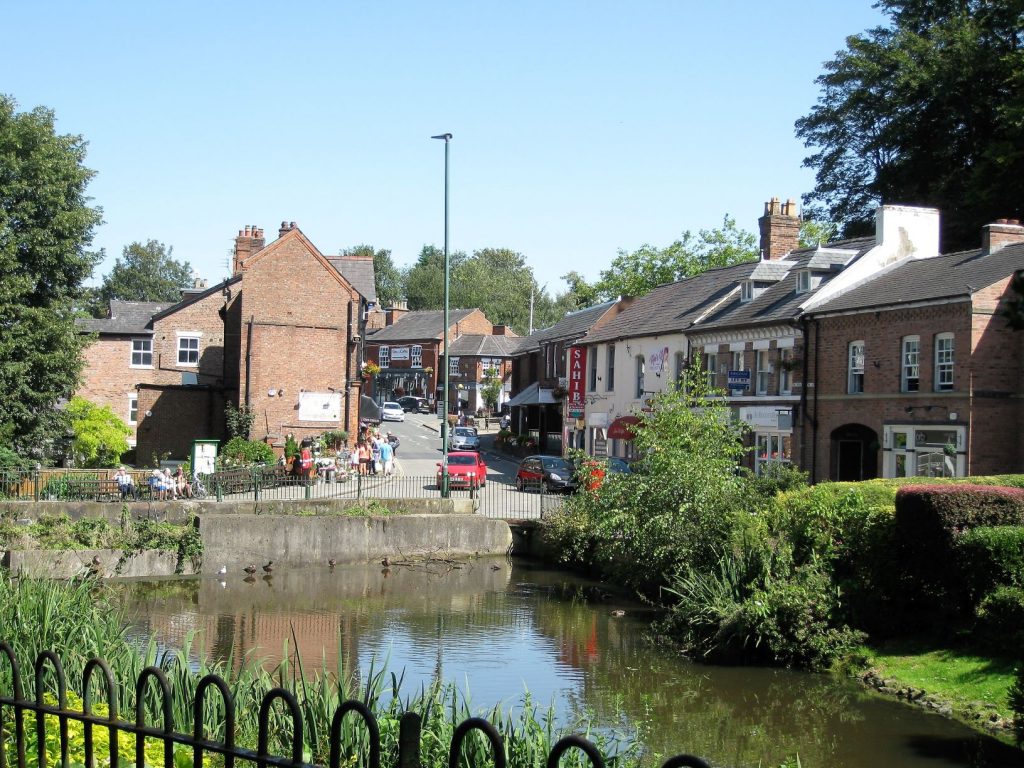

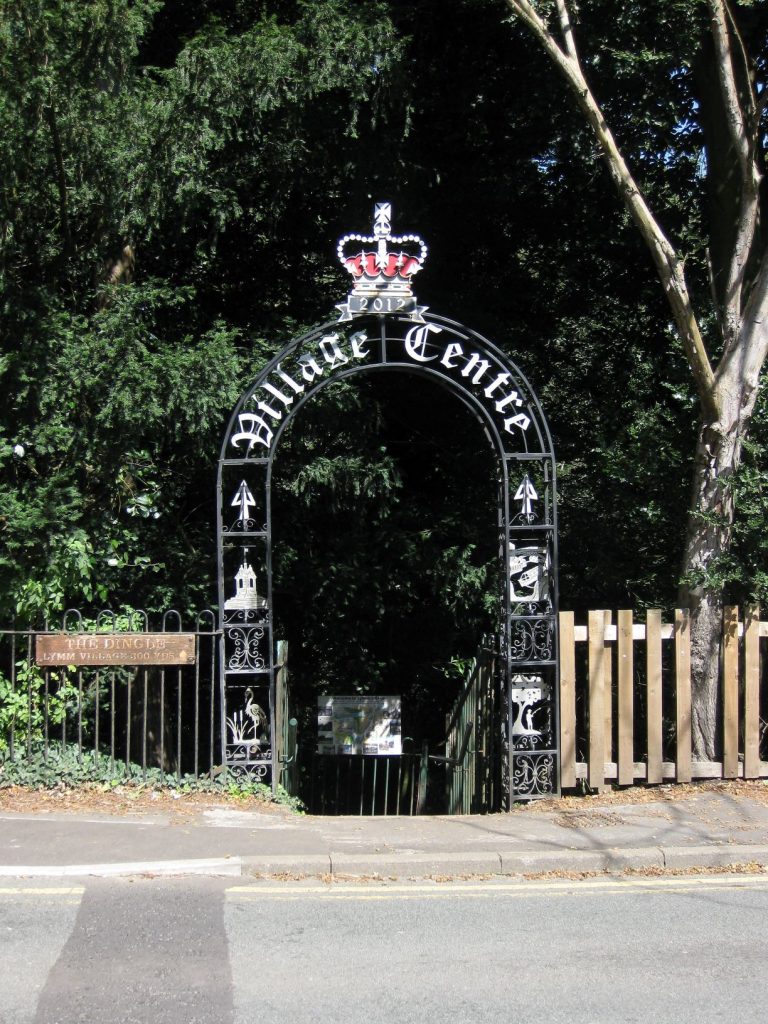

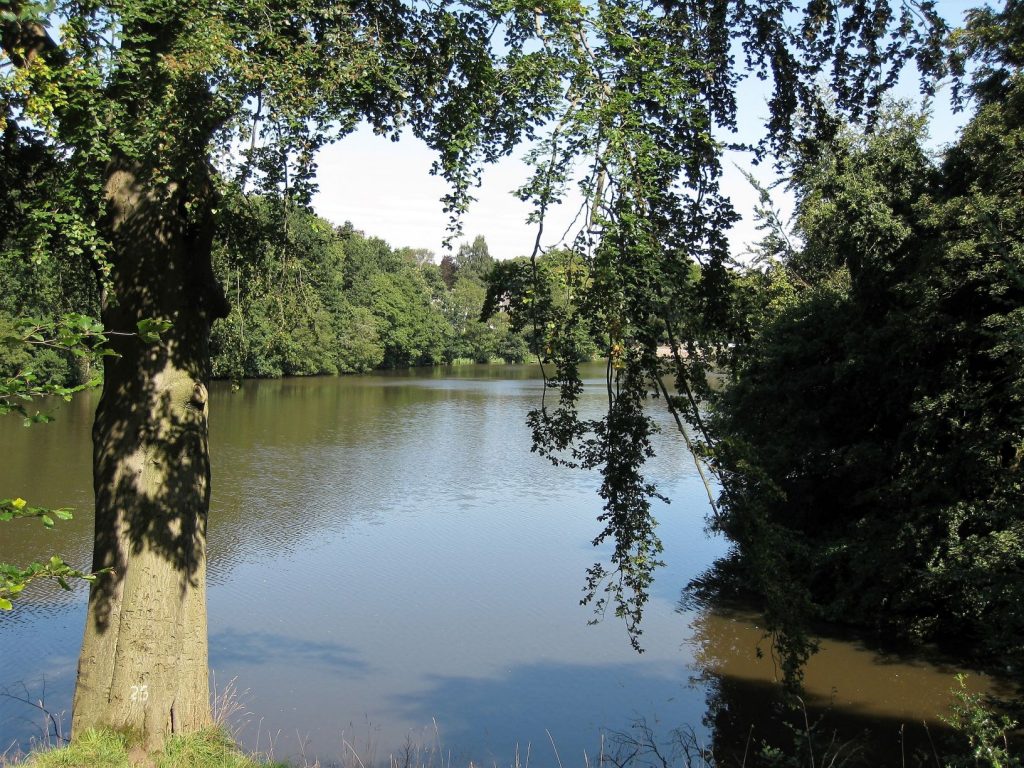
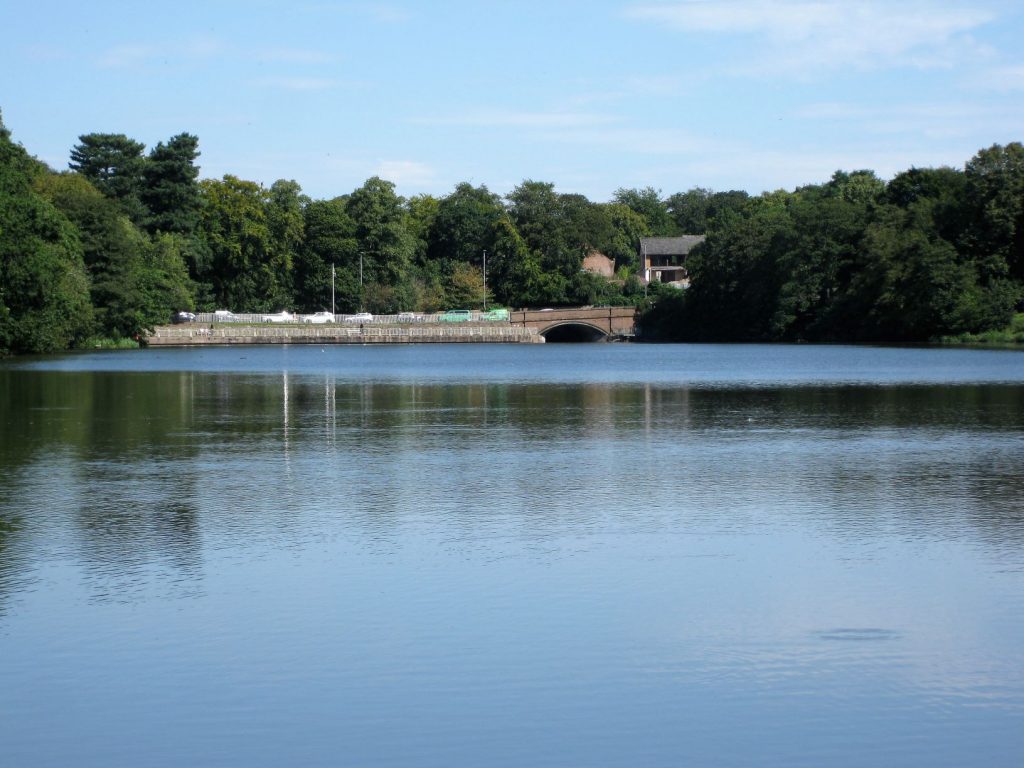
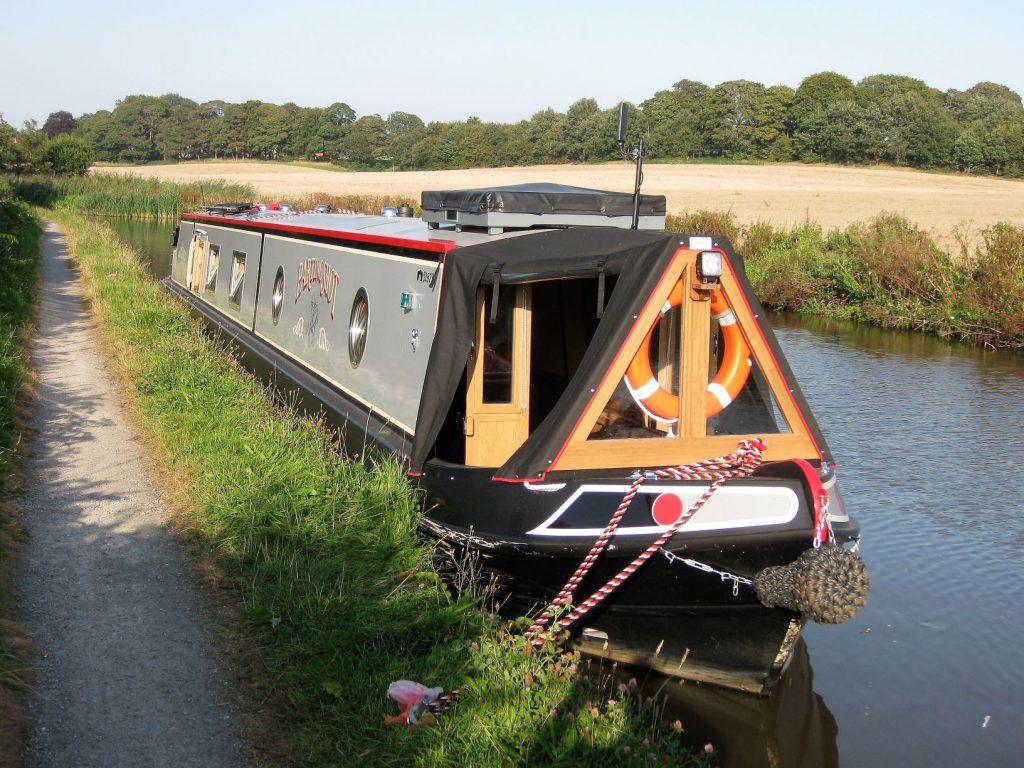

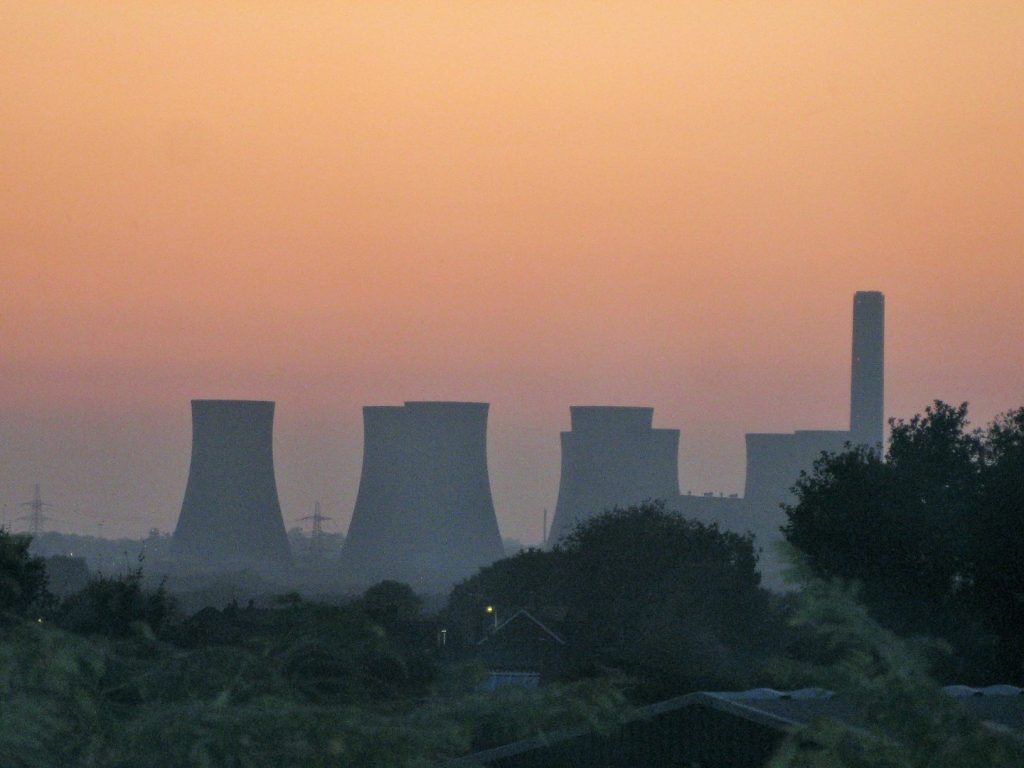
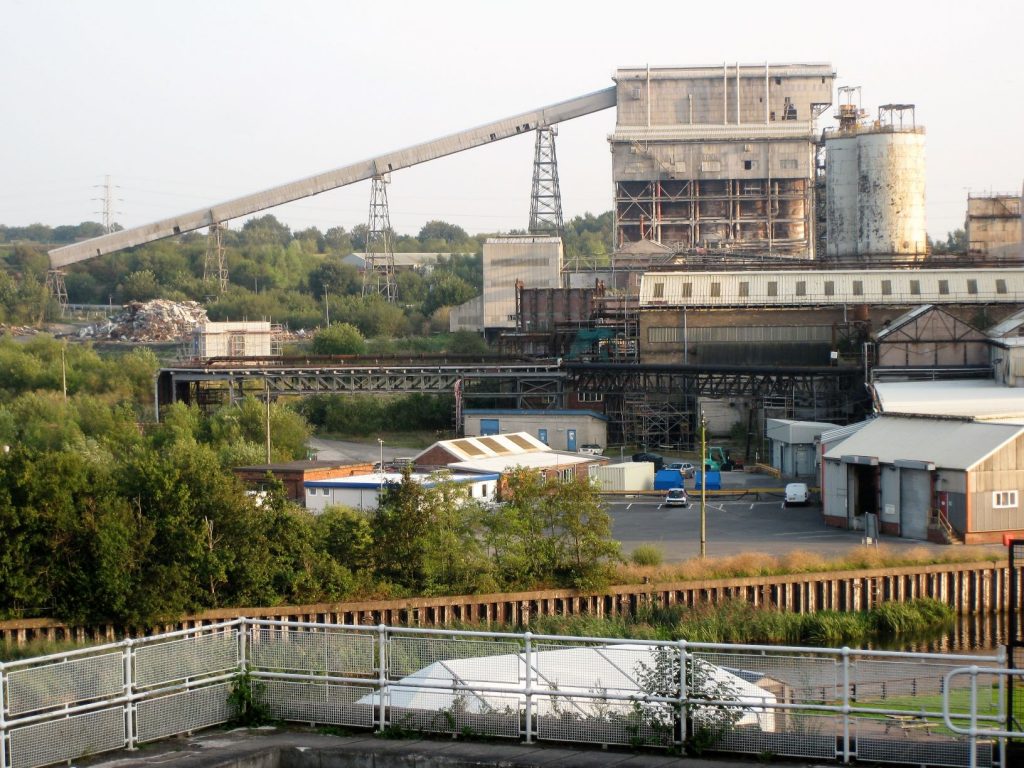
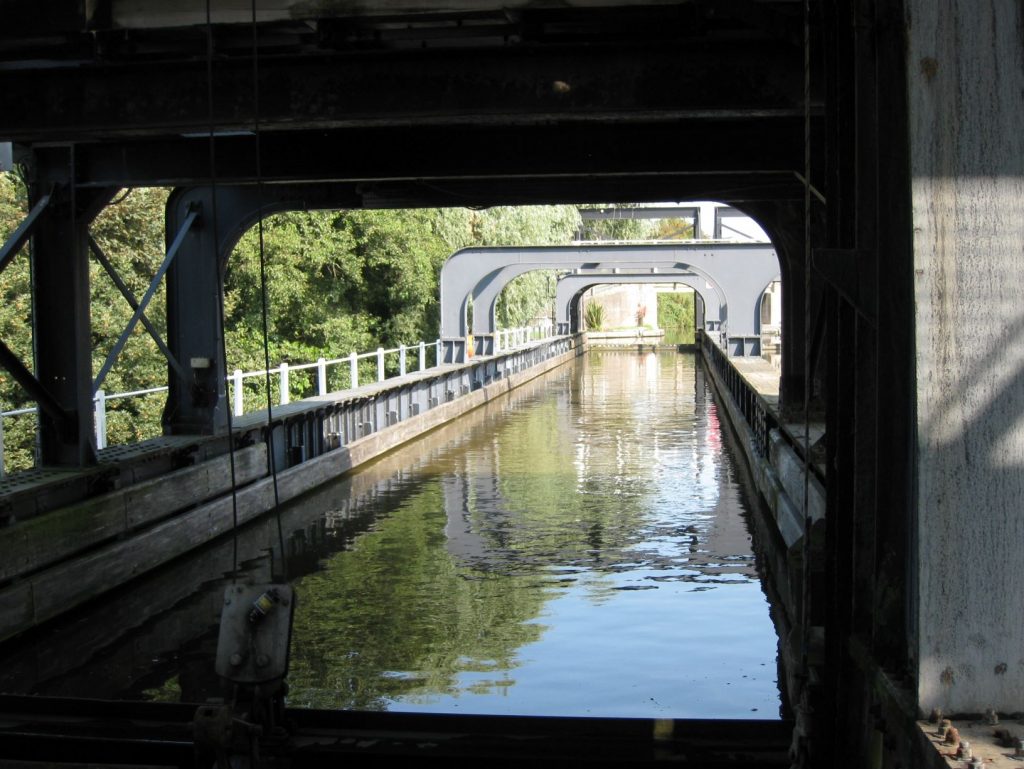
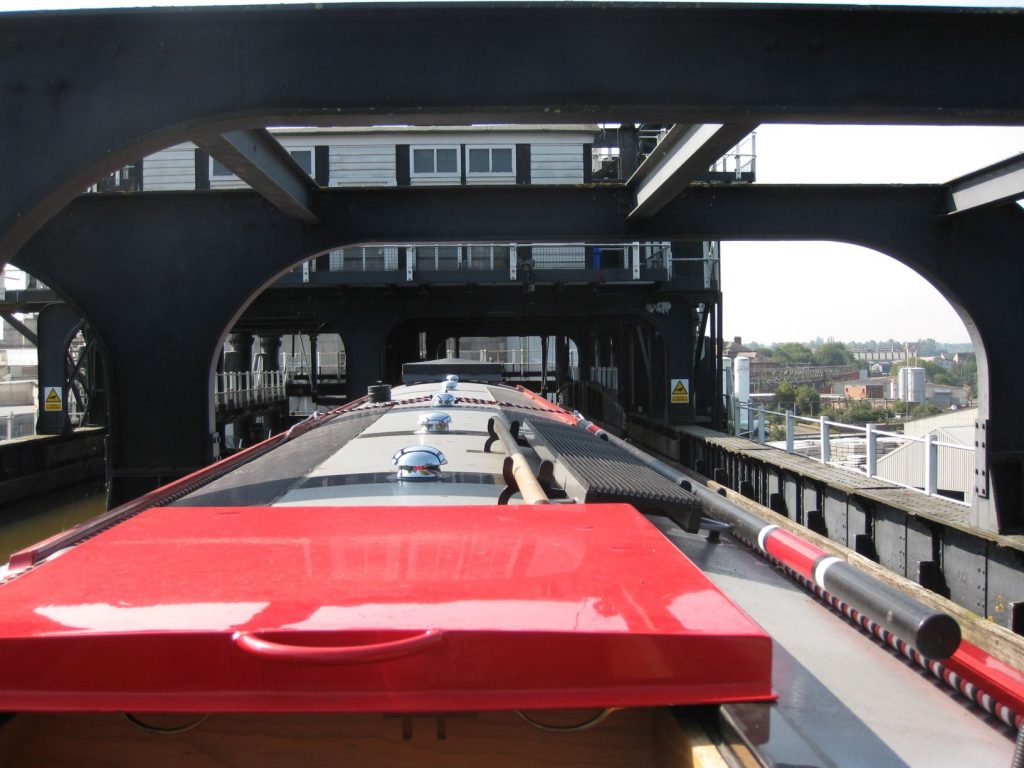

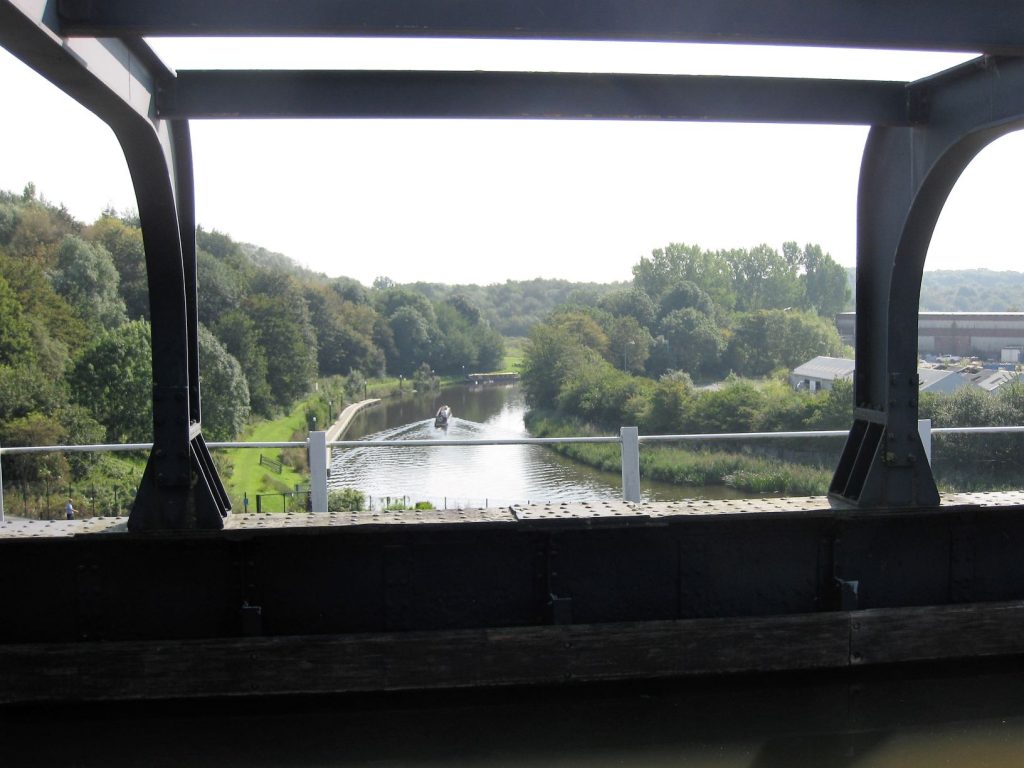
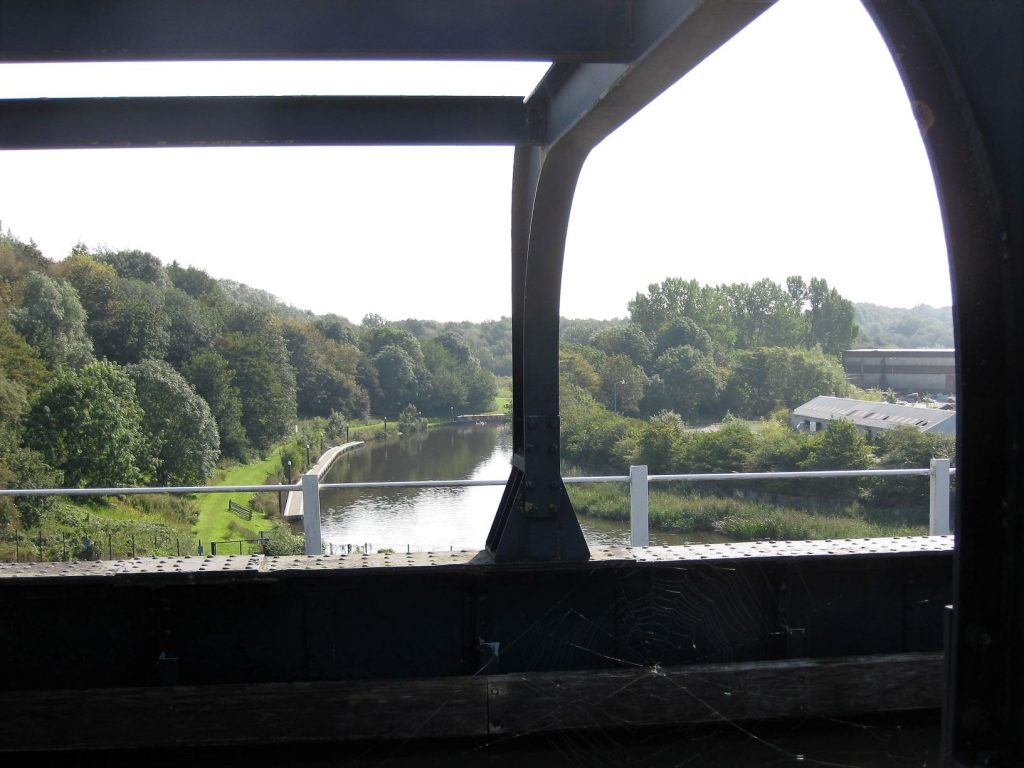
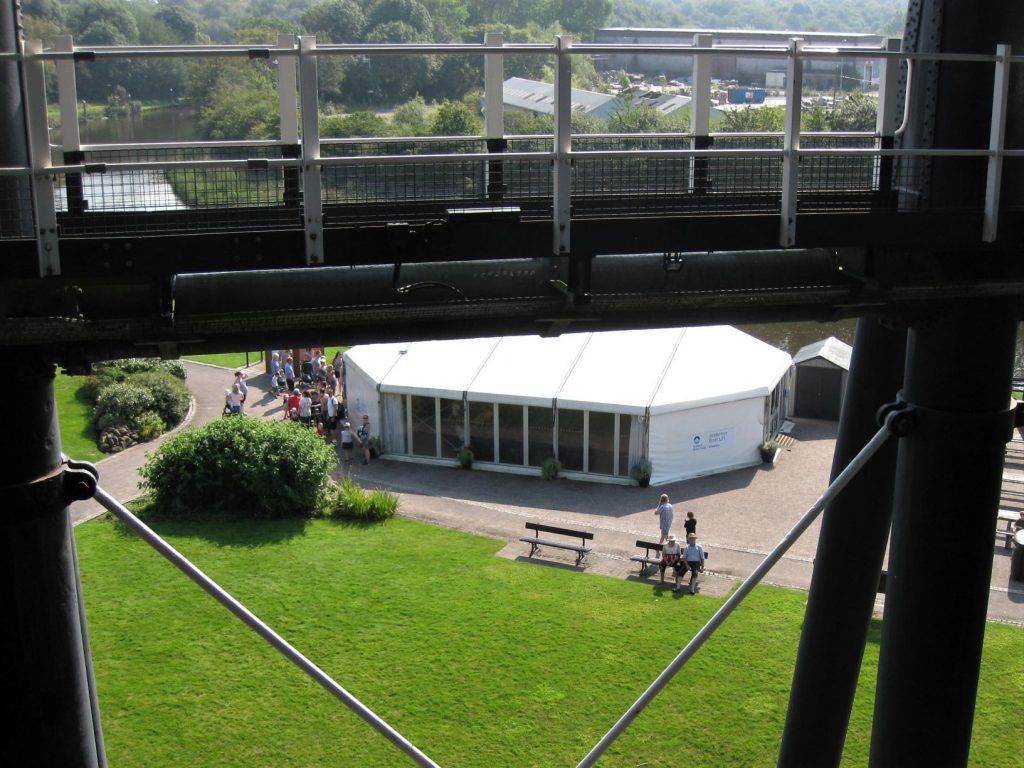
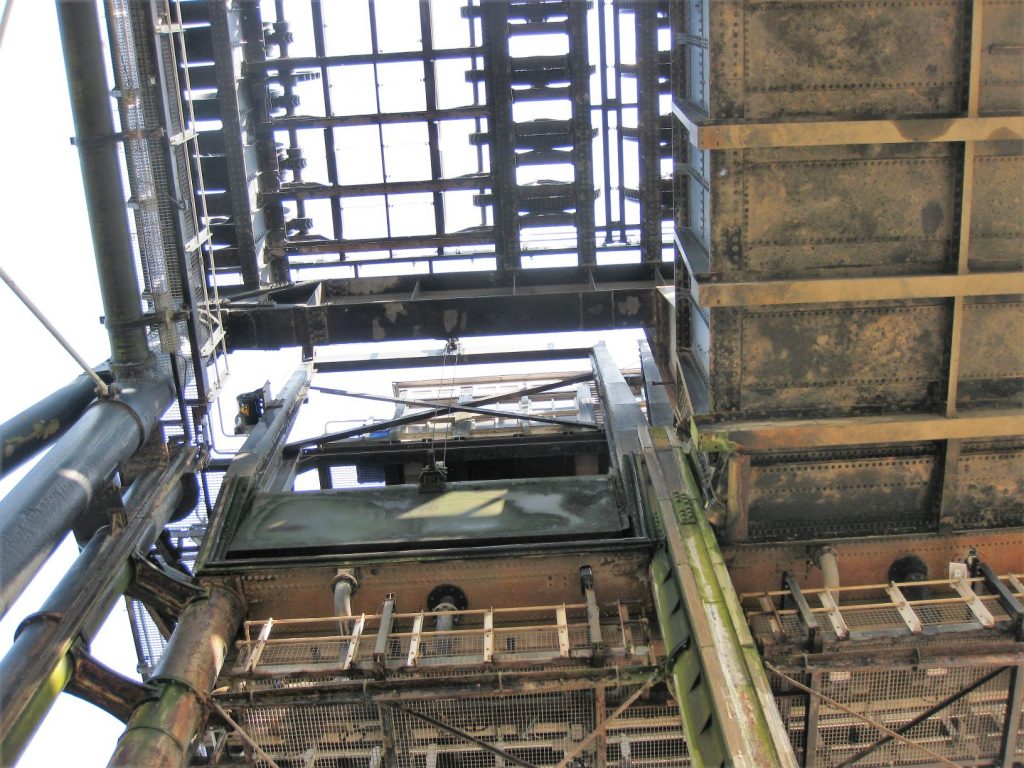

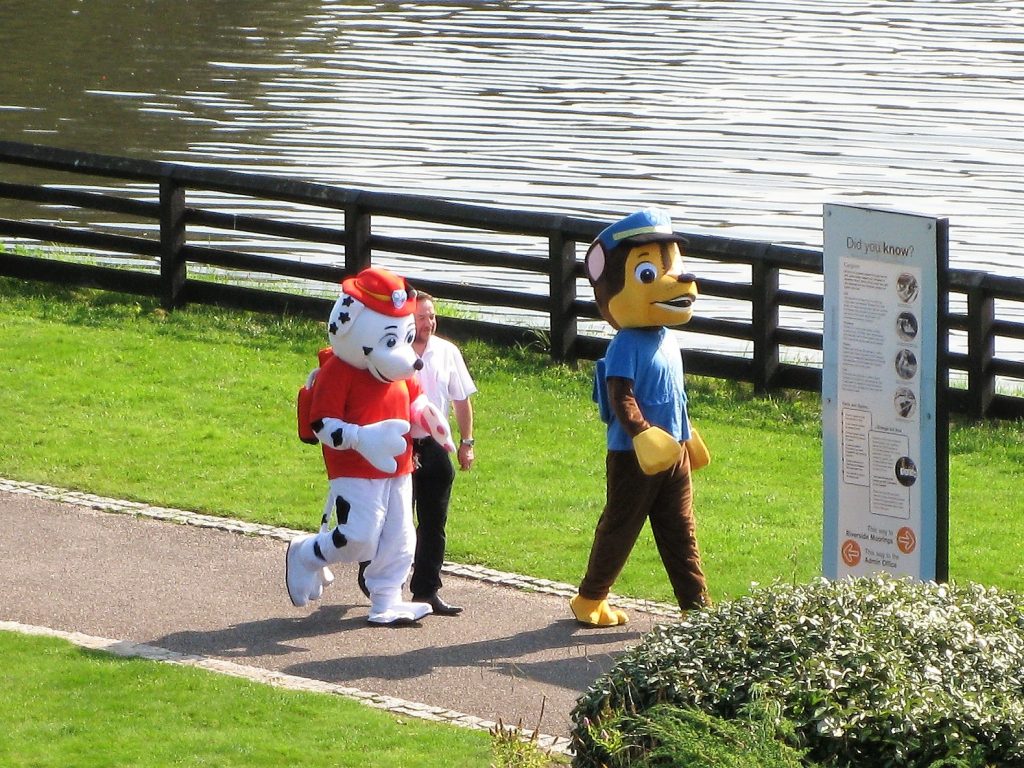
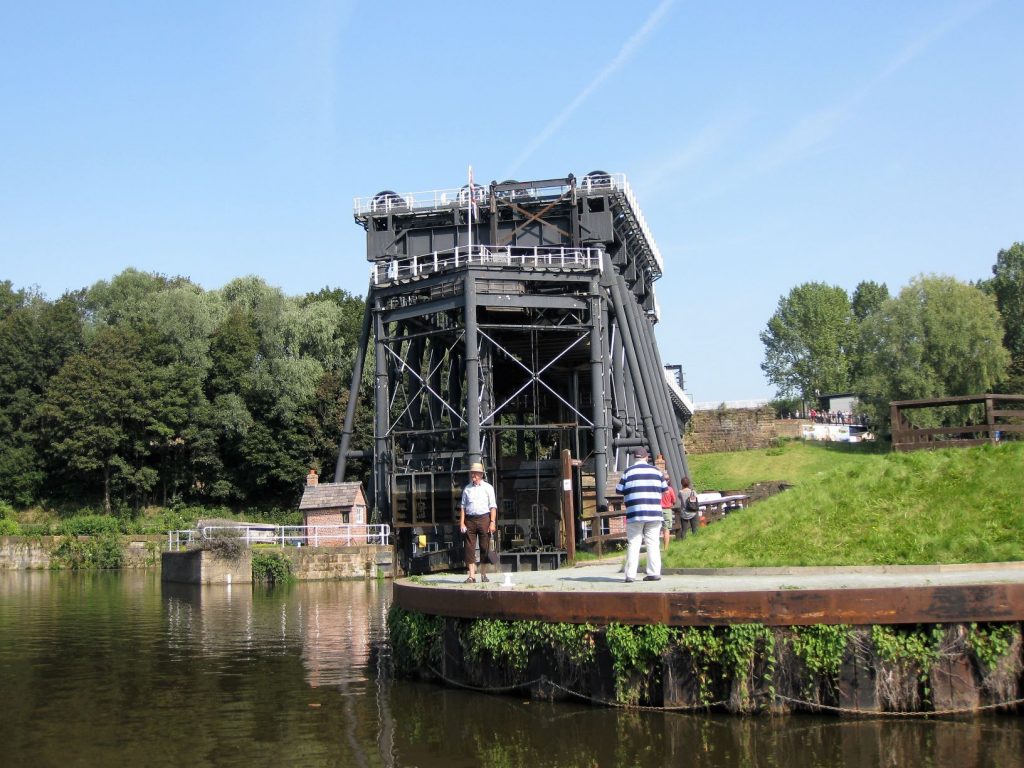
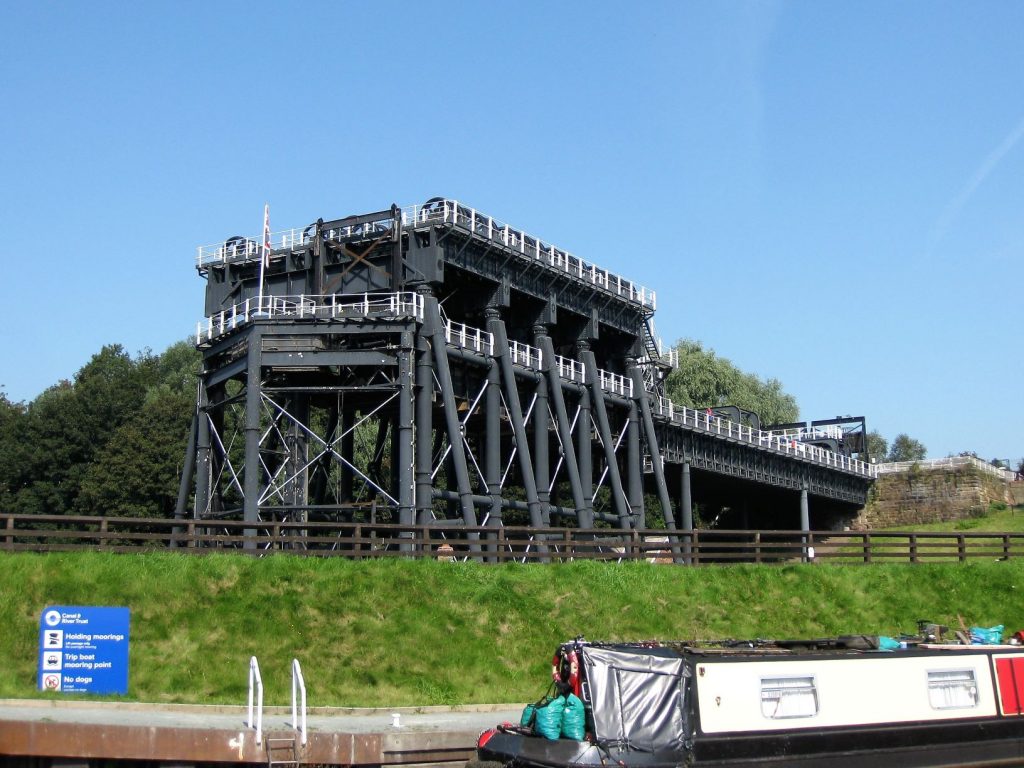
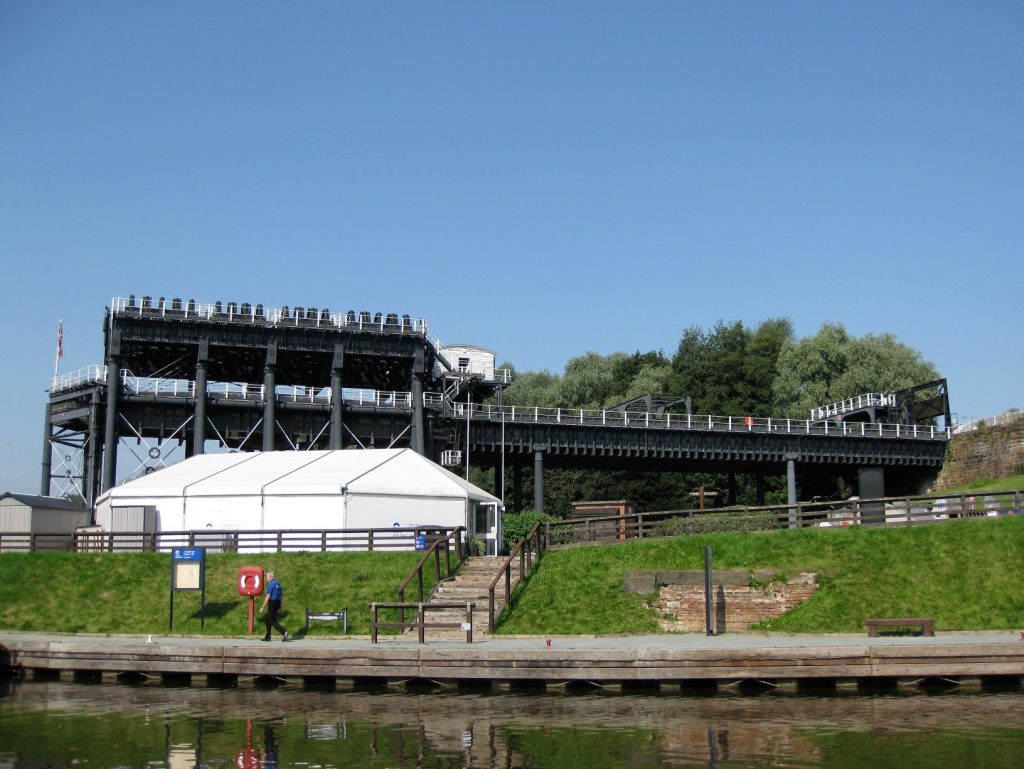
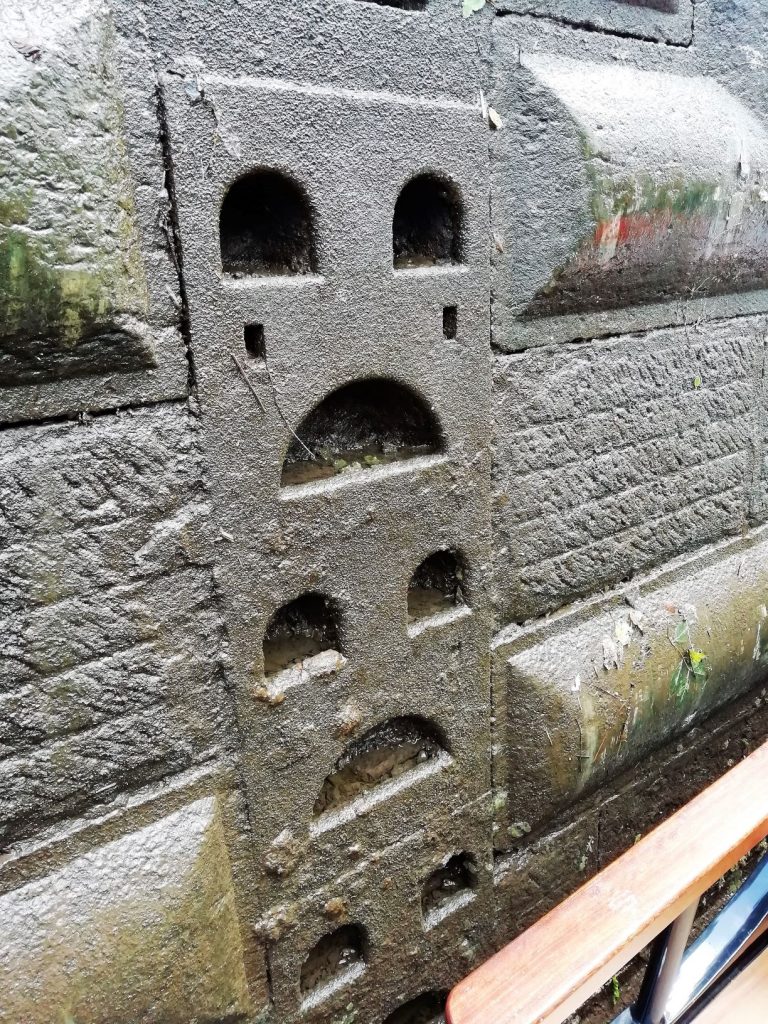
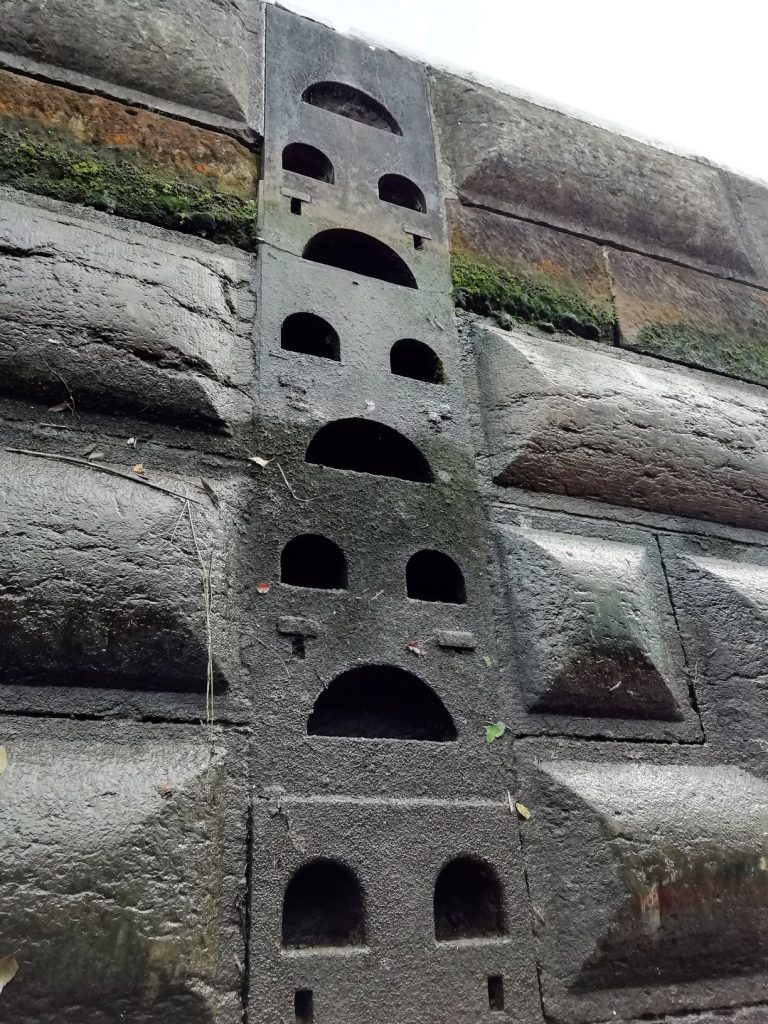
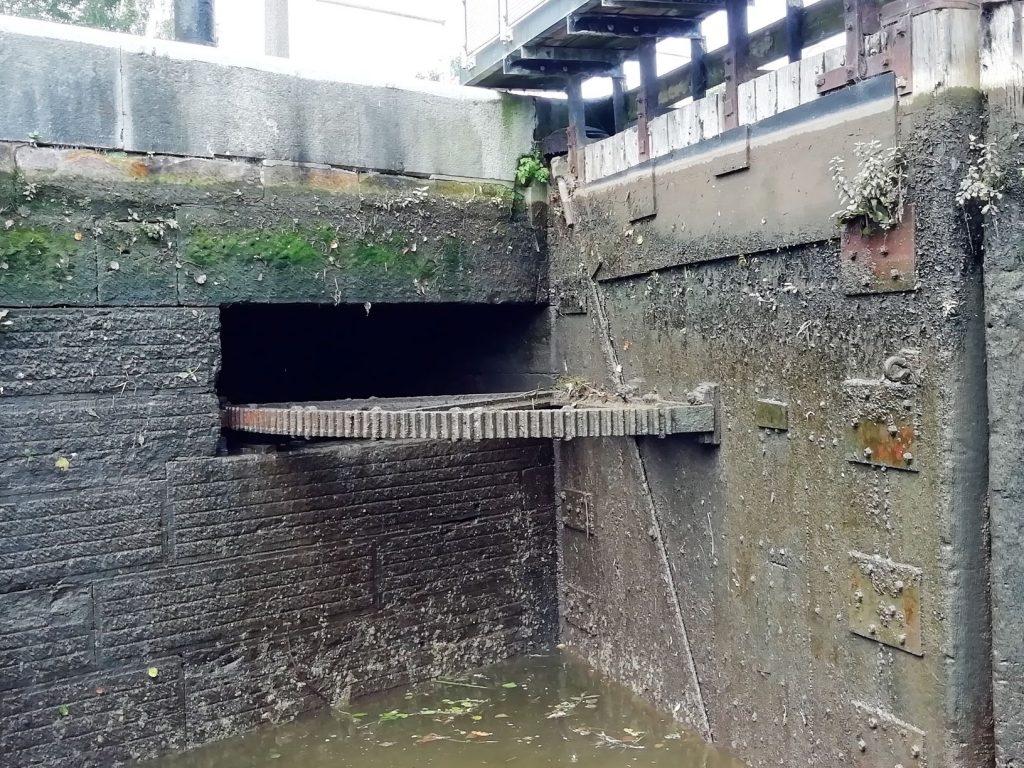
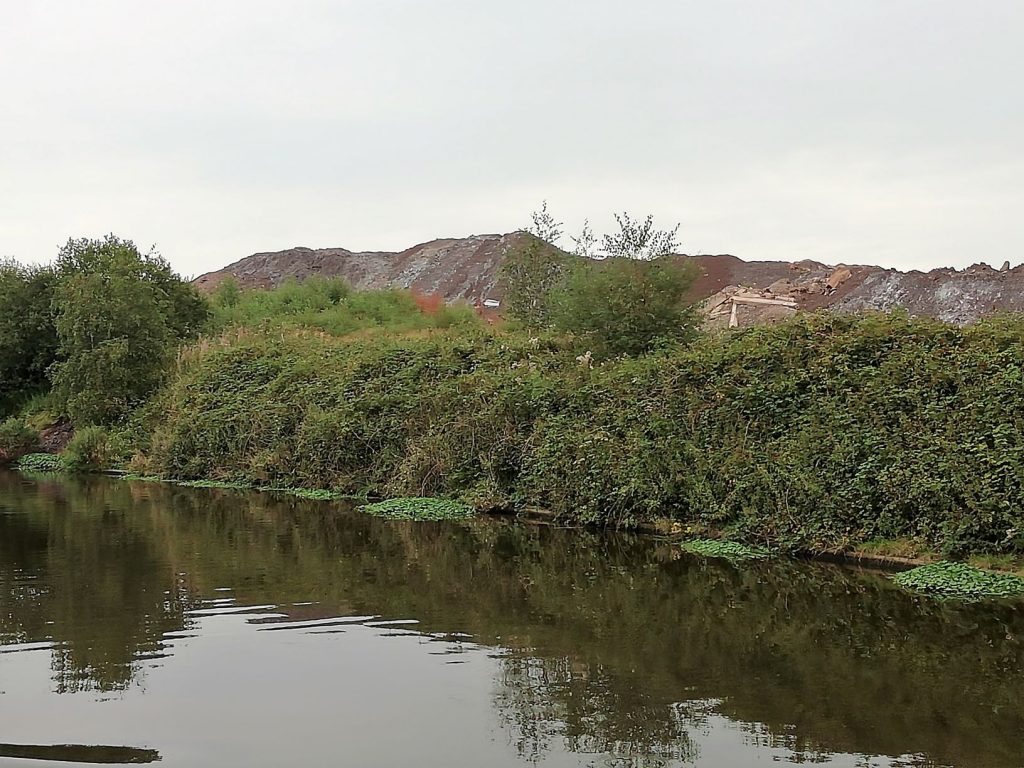

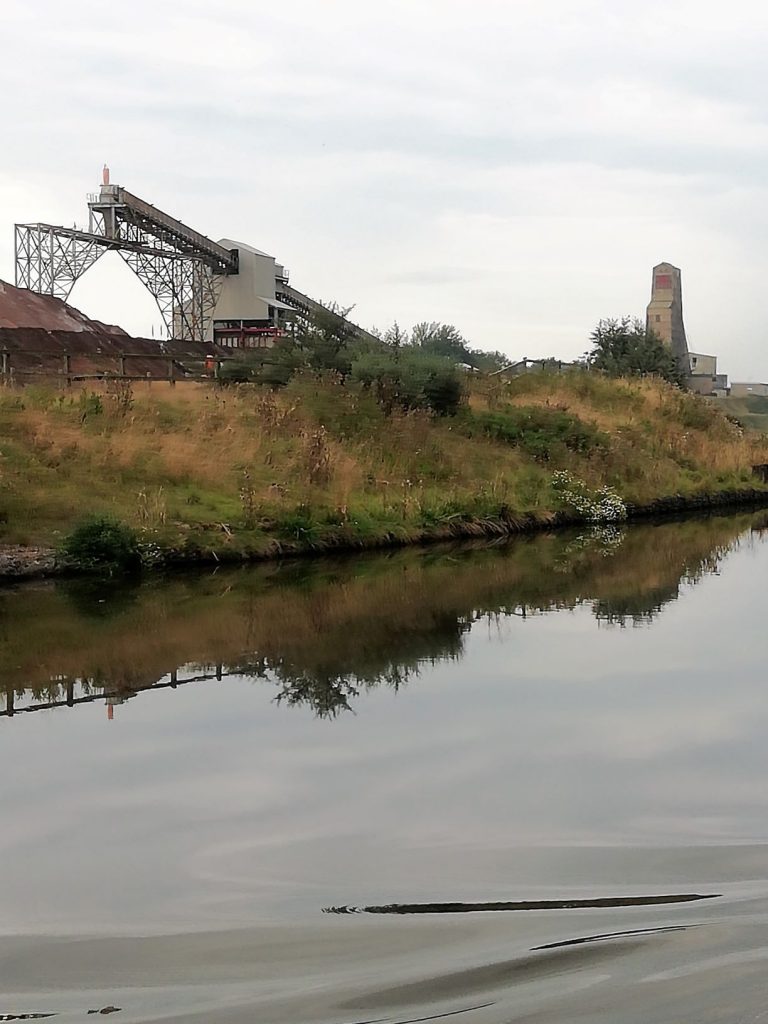

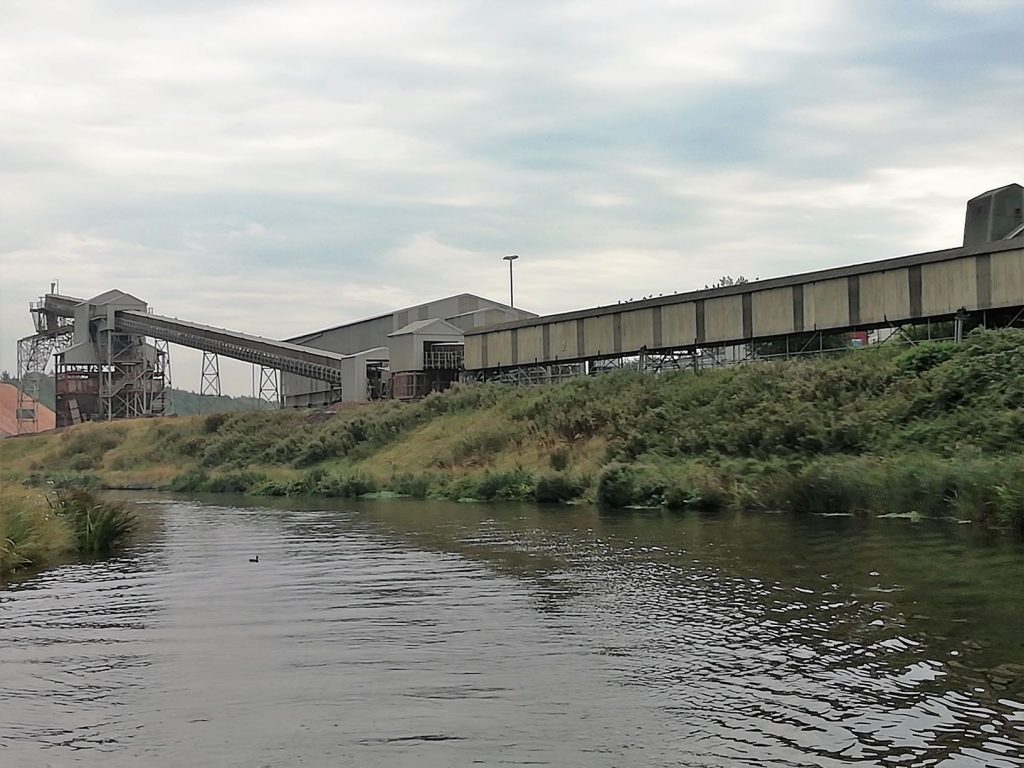
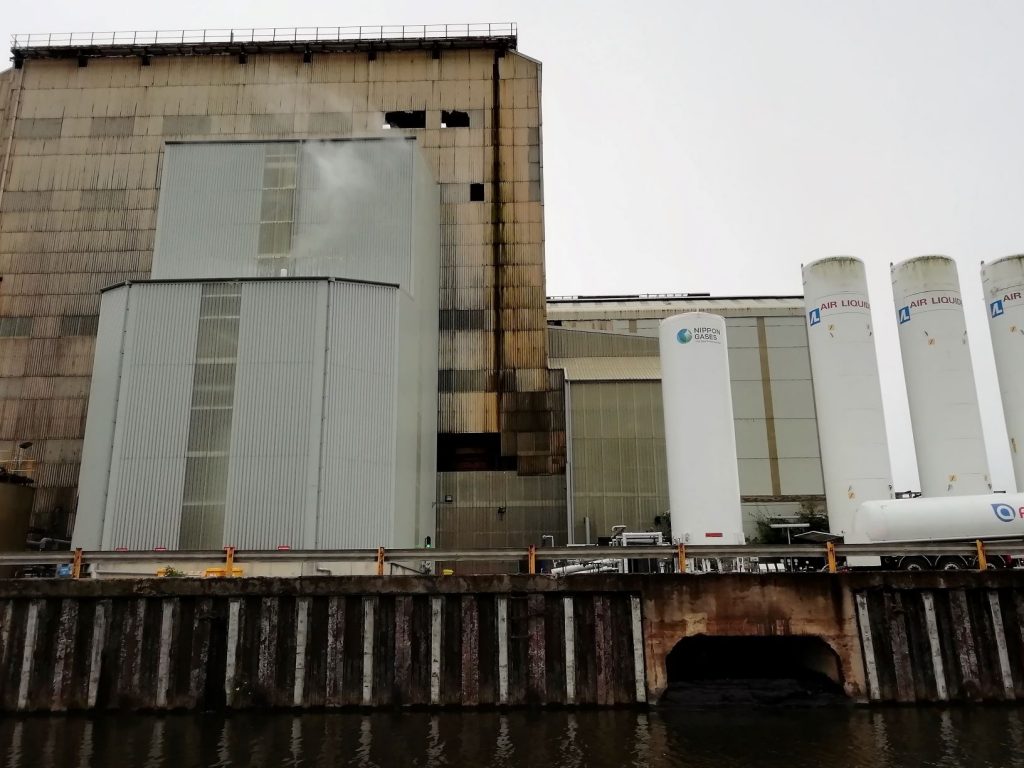
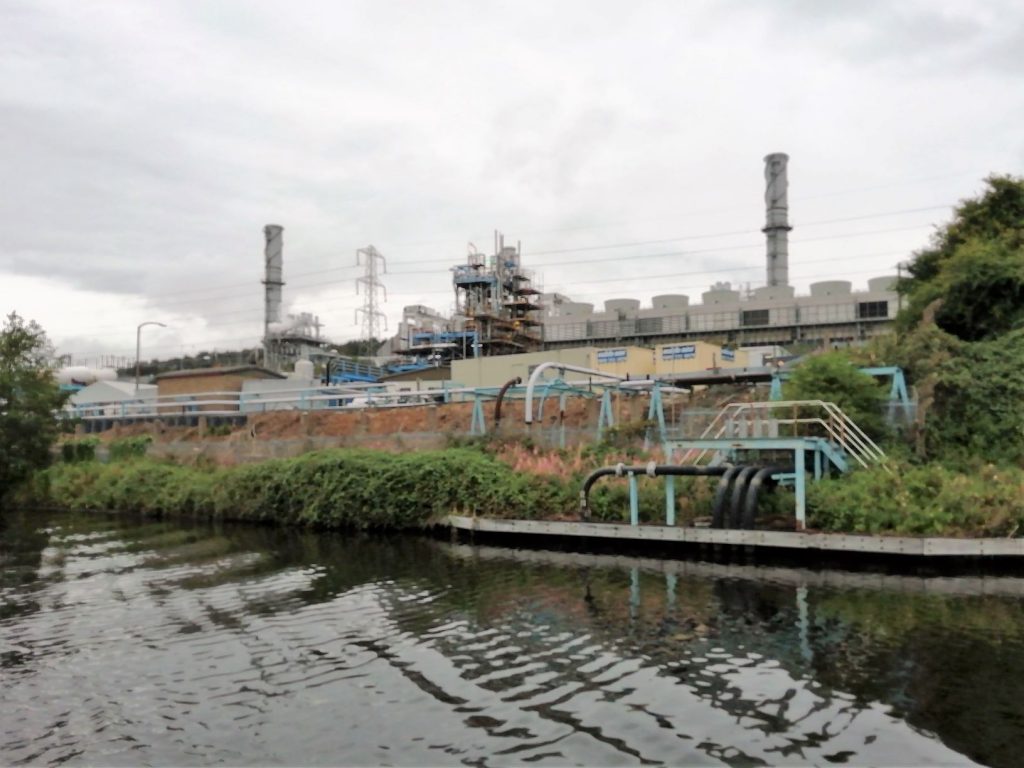
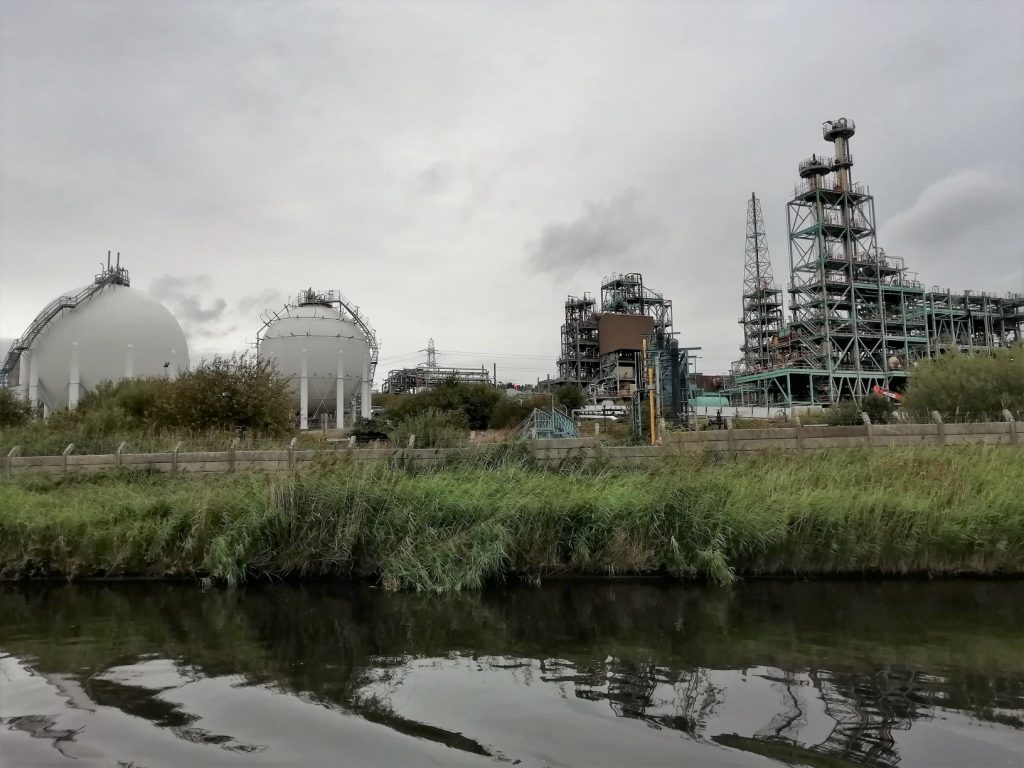

Your trips are real adventures, and also seem like quite hard work at times too – thank goodness for pubs! You must have to do a lot of research as well into where you are going ( and which pubs 😀). That lift bridge is amazing. Hope you manage to sort Bracken out. Great pictures,
Lots of love to you both, Chrissie x x
Hi Chrissie. Nice to hear from you. How / where are you these days?